load capacity TOYOTA AVENSIS 2013 Owners Manual (in English)
[x] Cancel search | Manufacturer: TOYOTA, Model Year: 2013, Model line: AVENSIS, Model: TOYOTA AVENSIS 2013Pages: 772, PDF Size: 34.43 MB
Page 332 of 772
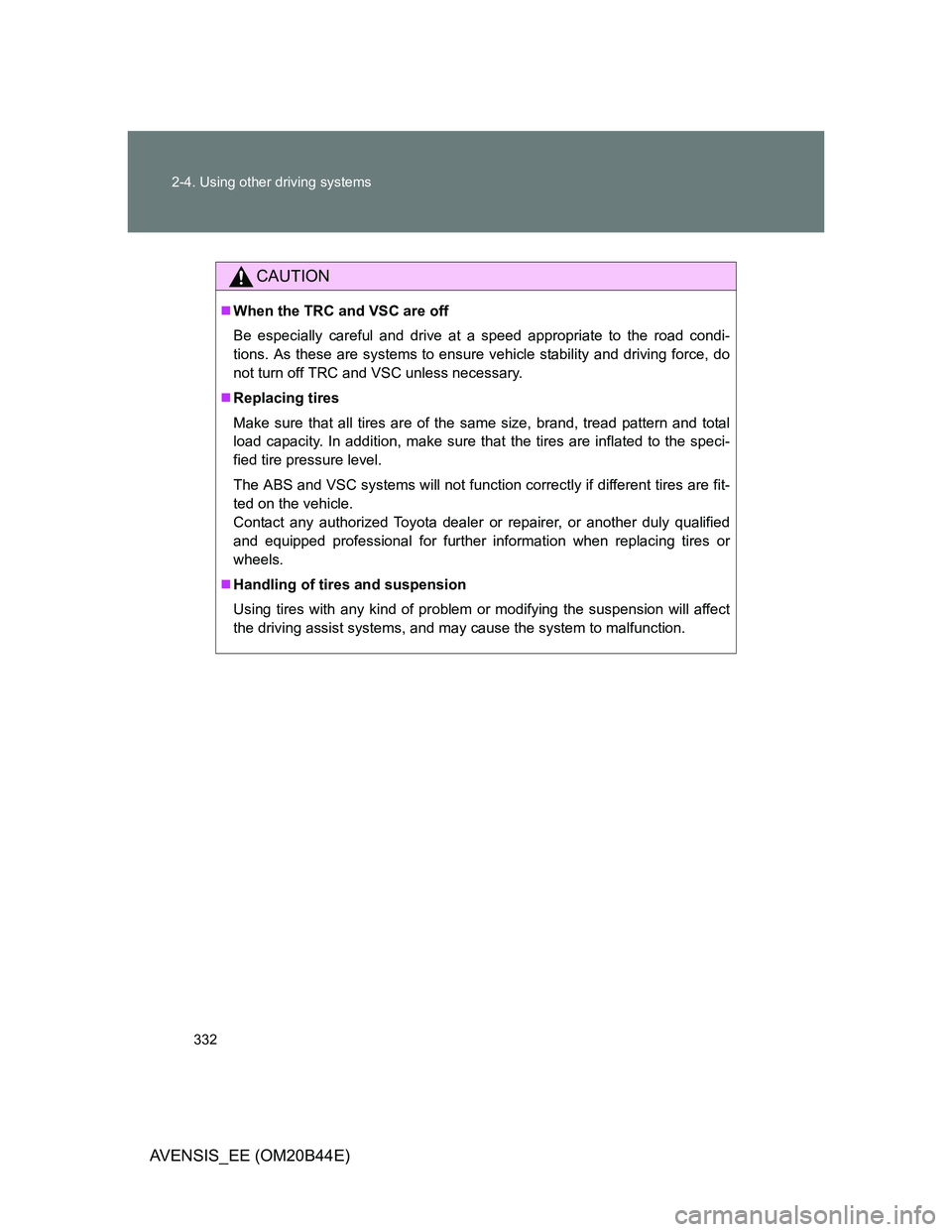
332 2-4. Using other driving systems
AVENSIS_EE (OM20B44E)
CAUTION
When the TRC and VSC are off
Be especially careful and drive at a speed appropriate to the road condi-
tions. As these are systems to ensure vehicle stability and driving force, do
not turn off TRC and VSC unless necessary.
Replacing tires
Make sure that all tires are of the same size, brand, tread pattern and total
load capacity. In addition, make sure that the tires are inflated to the speci-
fied tire pressure level.
The ABS and VSC systems will not function correctly if different tires are fit-
ted on the vehicle.
Contact any authorized Toyota dealer or repairer, or another duly qualified
and equipped professional for further information when replacing tires or
wheels.
Handling of tires and suspension
Using tires with any kind of problem or modifying the suspension will affect
the driving assist systems, and may cause the system to malfunction.
Page 342 of 772
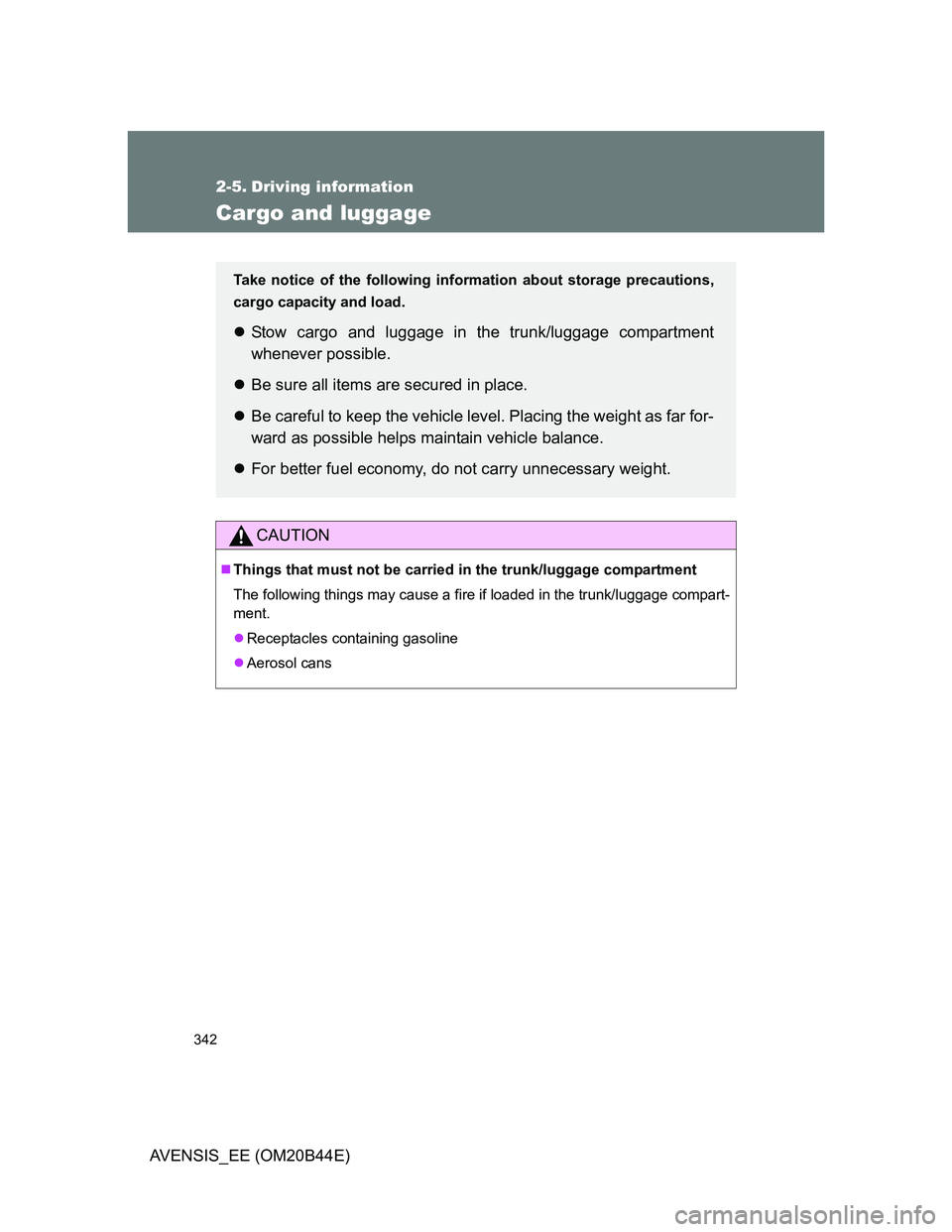
342
AVENSIS_EE (OM20B44E)
2-5. Driving information
Cargo and luggage
CAUTION
Things that must not be carried in the trunk/luggage compartment
The following things may cause a fire if loaded in the trunk/luggage compart-
ment.
Receptacles containing gasoline
Aerosol cans
Take notice of the following information about storage precautions,
cargo capacity and load.
Stow cargo and luggage in the trunk/luggage compartment
whenever possible.
Be sure all items are secured in place.
Be careful to keep the vehicle level. Placing the weight as far for-
ward as possible helps maintain vehicle balance.
For better fuel economy, do not carry unnecessary weight.
Page 348 of 772
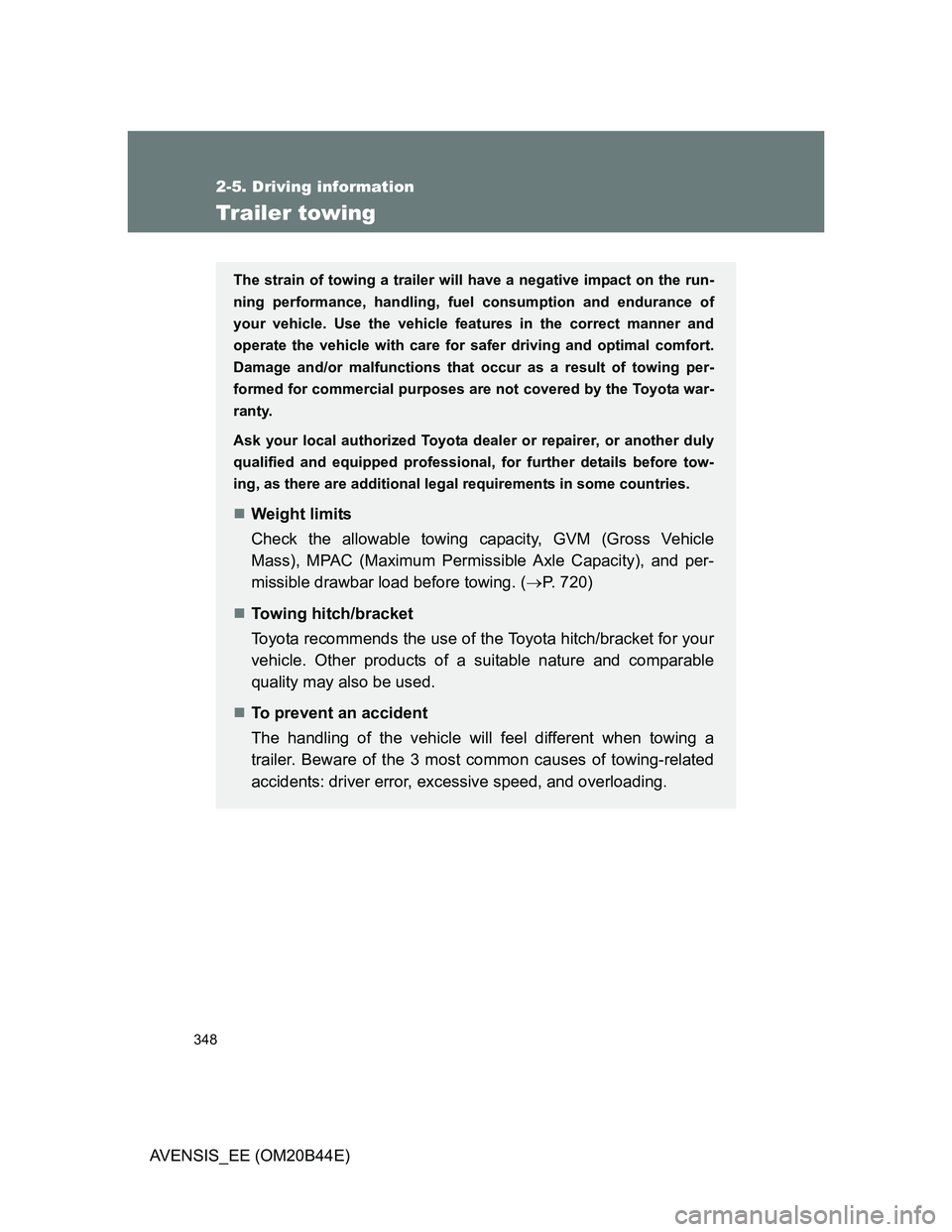
348
2-5. Driving information
AVENSIS_EE (OM20B44E)
Trailer towing
The strain of towing a trailer will have a negative impact on the run-
ning performance, handling, fuel consumption and endurance of
your vehicle. Use the vehicle features in the correct manner and
operate the vehicle with care for safer driving and optimal comfort.
Damage and/or malfunctions that occur as a result of towing per-
formed for commercial purposes are not covered by the Toyota war-
ranty.
Ask your local authorized Toyota dealer or repairer, or another duly
qualified and equipped professional, for further details before tow-
ing, as there are additional legal requirements in some countries.
Weight limits
Check the allowable towing capacity, GVM (Gross Vehicle
Mass), MPAC (Maximum Permissible Axle Capacity), and per-
missible drawbar load before towing. (P. 720)
Towing hitch/bracket
Toyota recommends the use of the Toyota hitch/bracket for your
vehicle. Other products of a suitable nature and comparable
quality may also be used.
To prevent an accident
The handling of the vehicle will feel different when towing a
trailer. Beware of the 3 most common causes of towing-related
accidents: driver error, excessive speed, and overloading.
Page 349 of 772
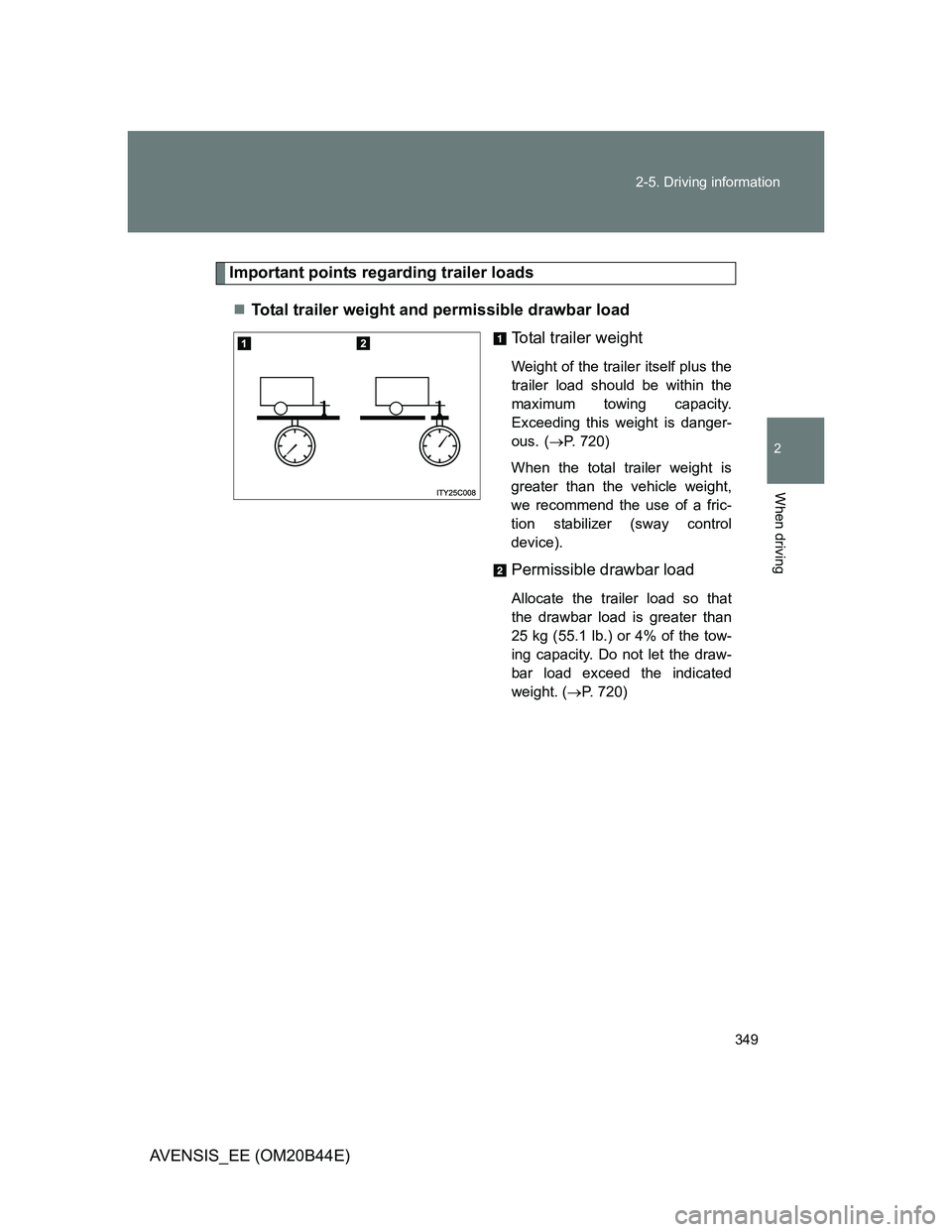
349 2-5. Driving information
2
When driving
AVENSIS_EE (OM20B44E)
Important points regarding trailer loads
Total trailer weight and permissible drawbar load
Total trailer weight
Weight of the trailer itself plus the
trailer load should be within the
maximum towing capacity.
Exceeding this weight is danger-
ous.
(P. 720)
When the total trailer weight is
greater than the vehicle weight,
we recommend the use of a fric-
tion stabilizer (sway control
device).
Permissible drawbar load
Allocate the trailer load so that
the drawbar load is greater than
25 kg (55.1 lb.) or 4% of the tow-
ing capacity. Do not let the draw-
bar load exceed the indicated
weight. (P. 720)
Page 350 of 772
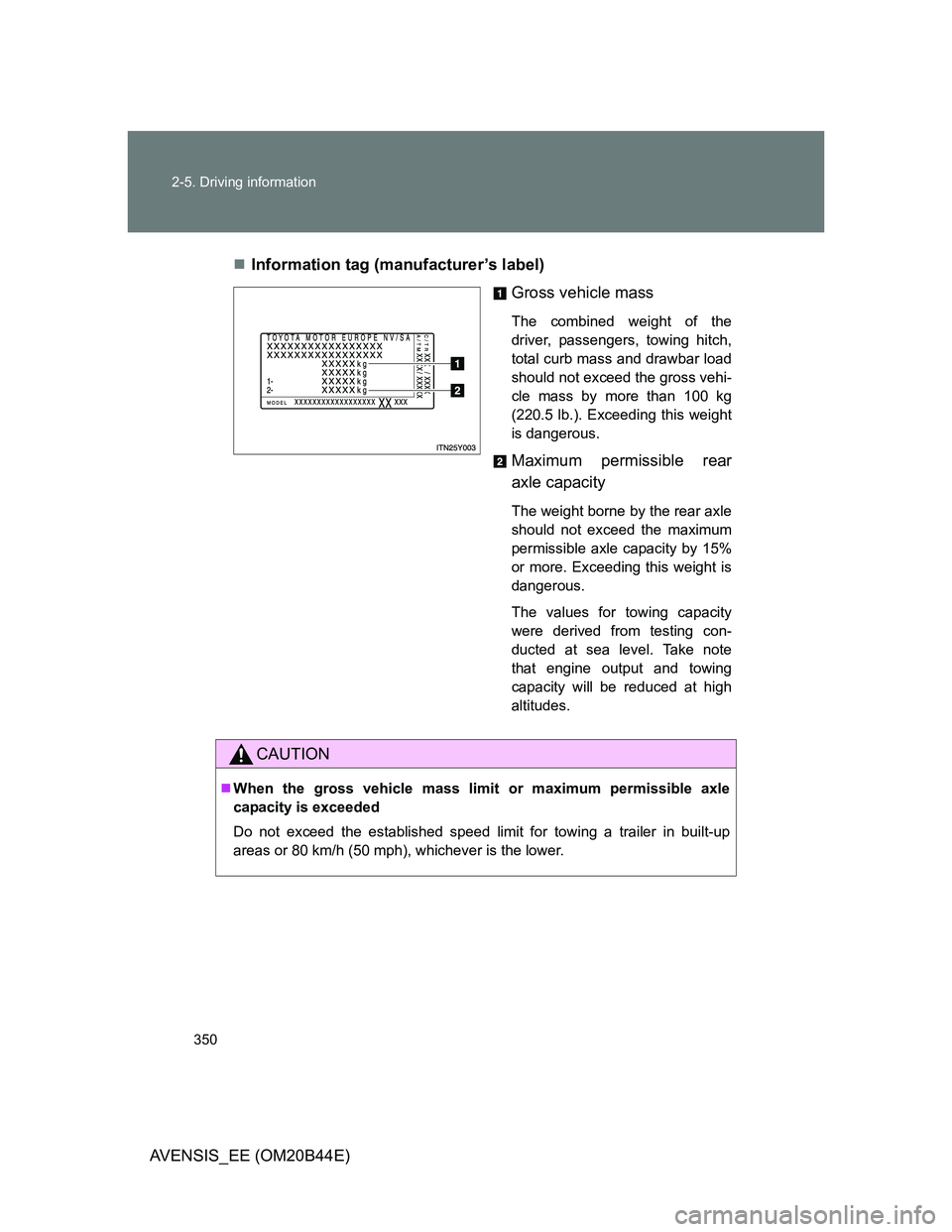
350 2-5. Driving information
AVENSIS_EE (OM20B44E)Information tag (manufacturer’s label)
Gross vehicle mass
The combined weight of the
driver, passengers, towing hitch,
total curb mass and drawbar load
should not exceed the gross vehi-
cle mass by more than 100 kg
(220.5 lb.). Exceeding this weight
is dangerous.
Maximum permissible rear
axle capacity
The weight borne by the rear axle
should not exceed the maximum
permissible axle capacity by 15%
or more. Exceeding this weight is
dangerous.
The values for towing capacity
were derived from testing con-
ducted at sea level. Take note
that engine output and towing
capacity will be reduced at high
altitudes.
CAUTION
When the gross vehicle mass limit or maximum permissible axle
capacity is exceeded
Do not exceed the established speed limit for towing a trailer in built-up
areas or 80 km/h (50 mph), whichever is the lower.
Page 555 of 772
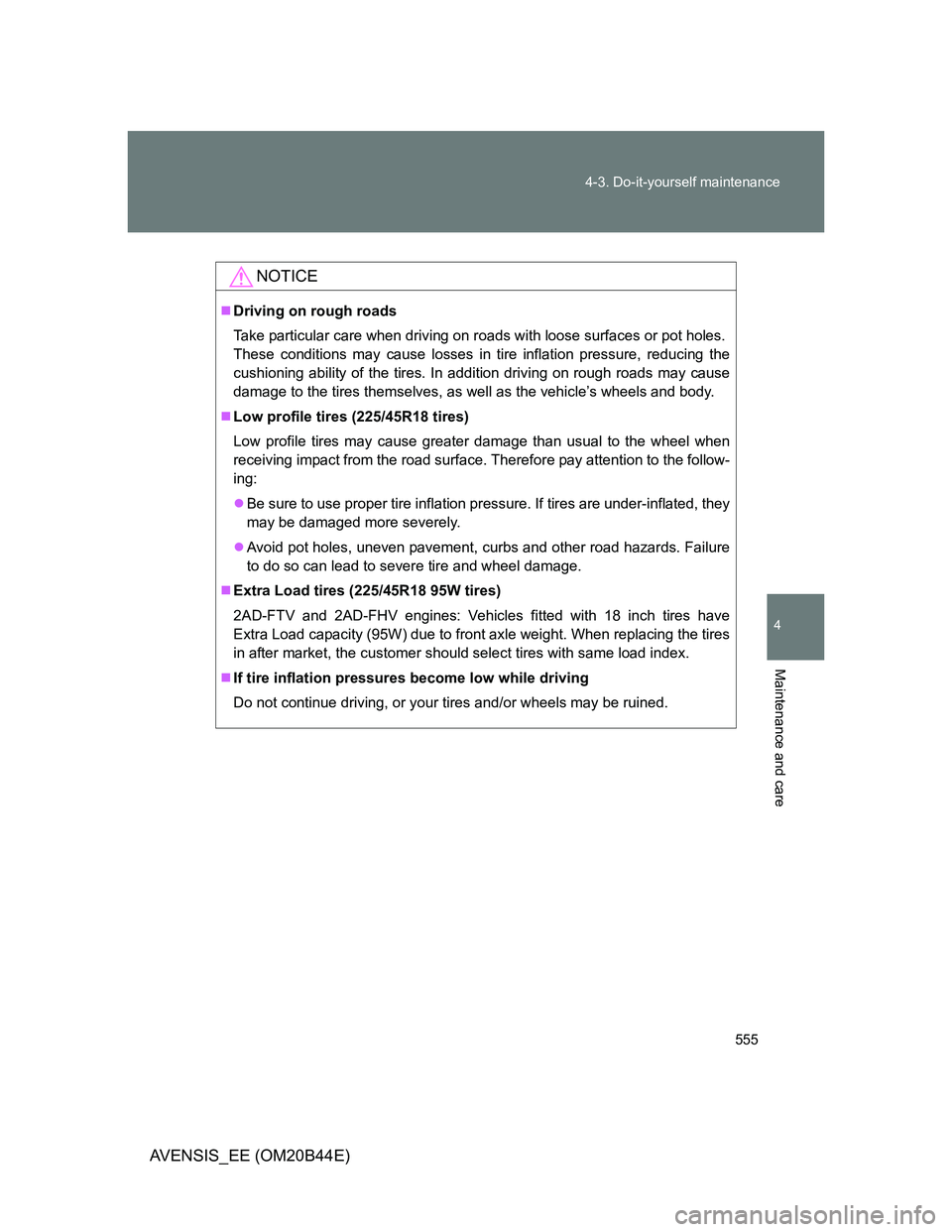
555 4-3. Do-it-yourself maintenance
4
Maintenance and care
AVENSIS_EE (OM20B44E)
NOTICE
Driving on rough roads
Take particular care when driving on roads with loose surfaces or pot holes.
These conditions may cause losses in tire inflation pressure, reducing the
cushioning ability of the tires. In addition driving on rough roads may cause
damage to the tires themselves, as well as the vehicle’s wheels and body.
Low profile tires (225/45R18 tires)
Low profile tires may cause greater damage than usual to the wheel when
receiving impact from the road surface. Therefore pay attention to the follow-
ing:
Be sure to use proper tire inflation pressure. If tires are under-inflated, they
may be damaged more severely.
Avoid pot holes, uneven pavement, curbs and other road hazards. Failure
to do so can lead to severe tire and wheel damage.
Extra Load tires (225/45R18 95W tires)
2AD-FTV and 2AD-FHV engines: Vehicles fitted with 18 inch tires have
Extra Load capacity (95W) due to front axle weight. When replacing the tires
in after market, the customer should select tires with same load index.
If tire inflation pressures become low while driving
Do not continue driving, or your tires and/or wheels may be ruined.
Page 558 of 772
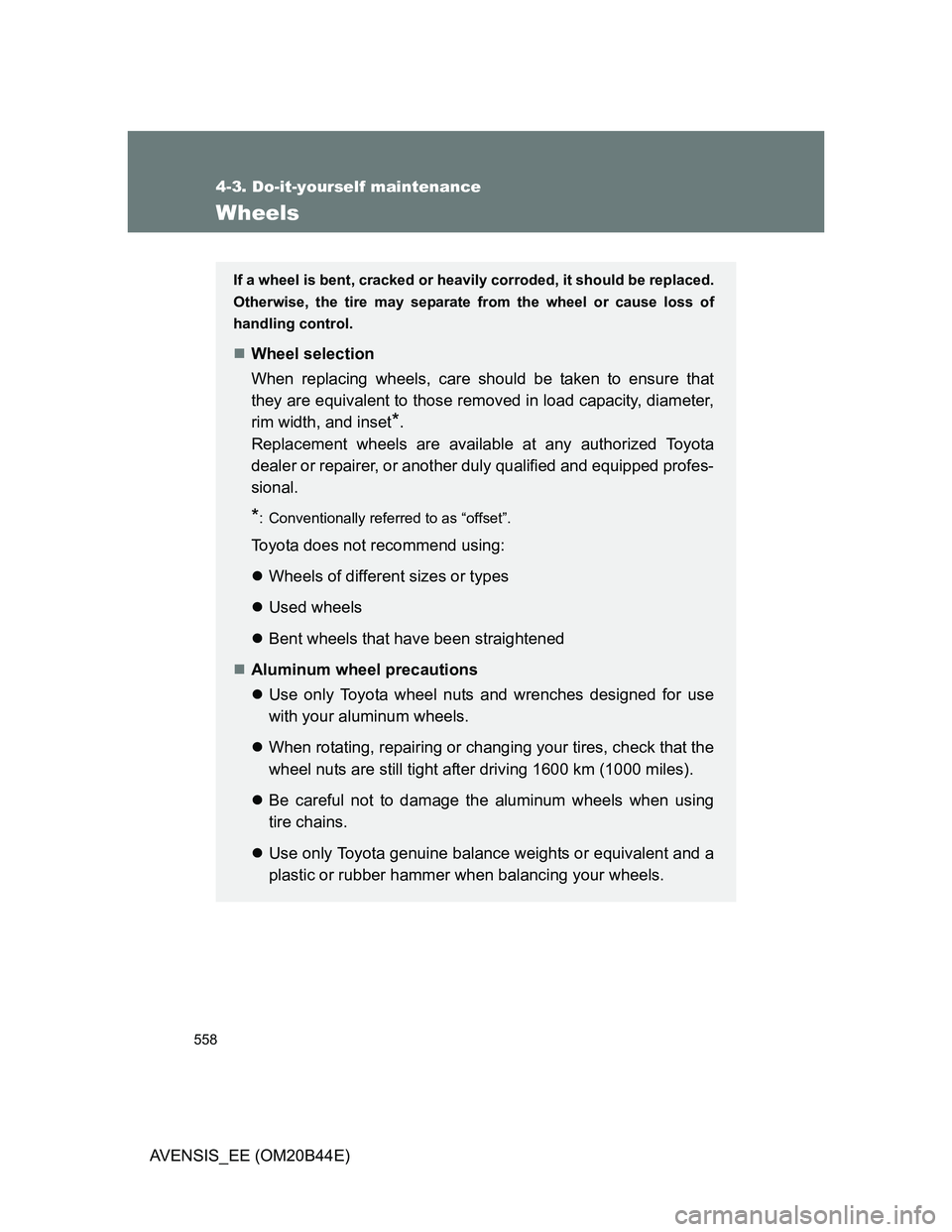
558
4-3. Do-it-yourself maintenance
AVENSIS_EE (OM20B44E)
Wheels
If a wheel is bent, cracked or heavily corroded, it should be replaced.
Otherwise, the tire may separate from the wheel or cause loss of
handling control.
Wheel selection
When replacing wheels, care should be taken to ensure that
they are equivalent to those removed in load capacity, diameter,
rim width, and inset
*.
Replacement wheels are available at any authorized Toyota
dealer or repairer, or another duly qualified and equipped profes-
sional.
*: Conventionally referred to as “offset”.
Toyota does not recommend using:
Wheels of different sizes or types
Used wheels
Bent wheels that have been straightened
Aluminum wheel precautions
Use only Toyota wheel nuts and wrenches designed for use
with your aluminum wheels.
When rotating, repairing or changing your tires, check that the
wheel nuts are still tight after driving 1600 km (1000 miles).
Be careful not to damage the aluminum wheels when using
tire chains.
Use only Toyota genuine balance weights or equivalent and a
plastic or rubber hammer when balancing your wheels.
Page 721 of 772
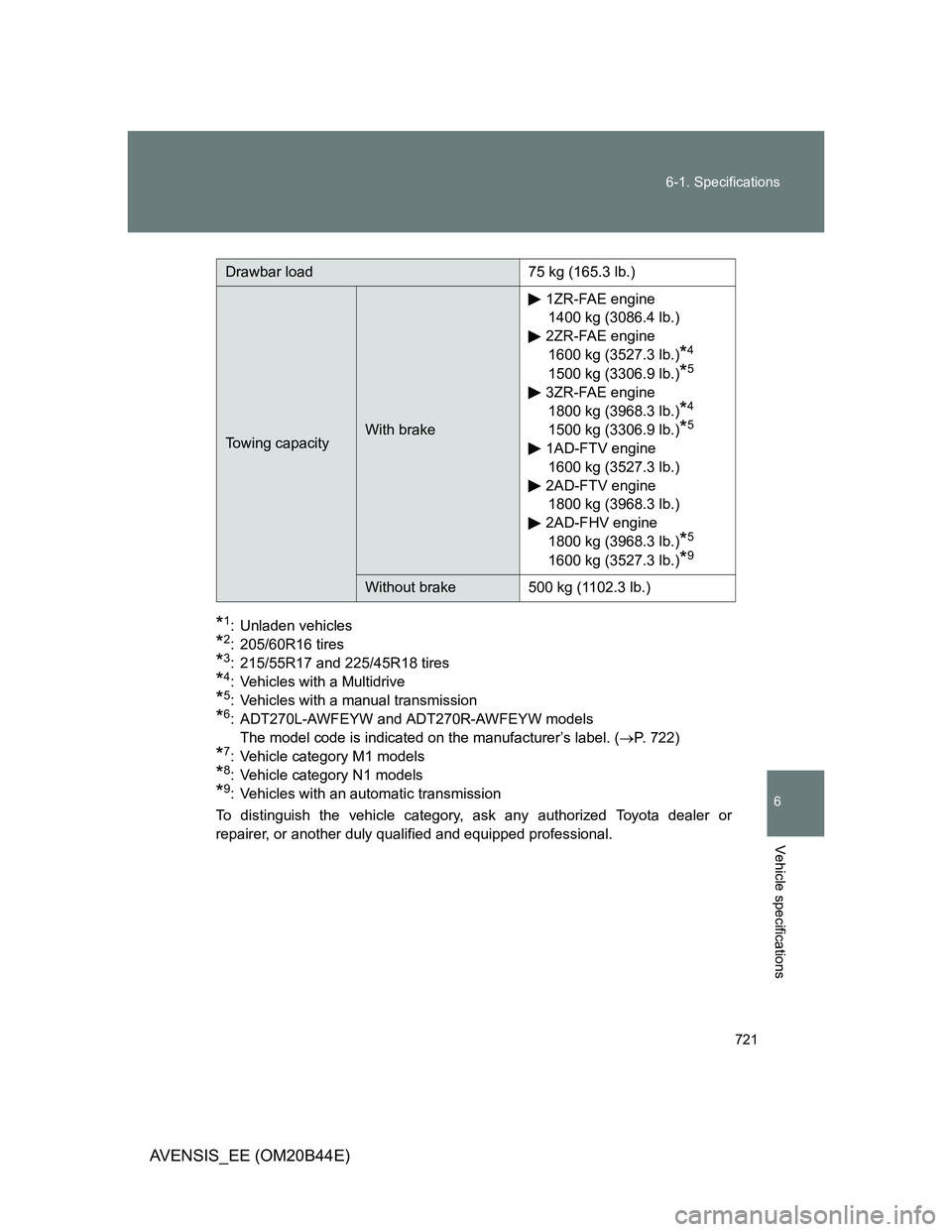
721 6-1. Specifications
6
Vehicle specifications
AVENSIS_EE (OM20B44E)
*1: Unladen vehicles
*2: 205/60R16 tires
*3: 215/55R17 and 225/45R18 tires
*4: Vehicles with a Multidrive
*5: Vehicles with a manual transmission
*6: ADT270L-AWFEYW and ADT270R-AWFEYW models
The model code is indicated on the manufacturer’s label. (P. 722)
*7: Vehicle category M1 models
*8: Vehicle category N1 models
*9: Vehicles with an automatic transmission
To distinguish the vehicle category, ask any authorized Toyota dealer or
repairer, or another duly qualified and equipped professional.
Drawbar load 75 kg (165.3 lb.)
Towing capacityWith brake1ZR-FAE engine
1400 kg (3086.4 lb.)
2ZR-FAE engine
1600 kg (3527.3 lb.)
*4
1500 kg (3306.9 lb.)*5
3ZR-FAE engine
1800 kg (3968.3 lb.)
*4
1500 kg (3306.9 lb.)*5
1AD-FTV engine
1600 kg (3527.3 lb.)
2AD-FTV engine
1800 kg (3968.3 lb.)
2AD-FHV engine
1800 kg (3968.3 lb.)
*5
1600 kg (3527.3 lb.)*9
Without brake 500 kg (1102.3 lb.)